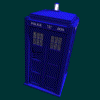The TARDIS Manual
Type 40
![]()
|
?????????????????????????????????????? |
?????????????????????????????????????? |
Introduction:
The TARDIS is a type 40 or Mark 1. The Time Lords created a time capsule, called a TARDIS. These machines are capable of traveling to any planet in the universe at any point in time in that planet's existence. The word TARDIS is an acronym for Time and Relative Dimensions in Space and the machine's primary purpose is as a research and study laboratory: at least that is what the Time Lords originally intended them to be used for.
The TARDIS:

The Doctor's TARDIS
In appearance the machine is like a square metal cabinet, entered by way of a single, sliding door on one face. But this appearance requires disguising for the varying and often dangerous missions upon which Time Lords engage and hence each possesses a chameleon circuit which enables it to take on any suitable appearance wherever it lands. The Doctor's TARDIS has, of course, been constantly seen in the guise of a 1960's Metropolitan Police call box, a fact which derives from a malfunction in the circuit which occurred when the Doctor materialized it on Earth millions of years in the past and since then it has been locked in that shape. The Doctor did, however, temporarily repair the Chameleon Circuit during his 6th Incarnation, which resulted in some interesting exterior forms before reverting back to its Police Box mode, and once again locking the shape down (Much to the Doctor's relief). This is not the only trouble which the Time Lord has experienced with his TARDIS, which he rescued from a junk yard on his flight from Gallifry, and it also has rather unpredictable and erratic steering.
Because of the extremes of speed and the varying types of atmosphere and conditions to which the TARDIS is subjected on its travels, not to mention the fire-power of its enemies, the craft is surrounded by its own enormously powerful force shield which makes it virtually invulnerable to any attack. Should the enemy attack seem to have any likelihood of succeeding, the TARDIS can, of course, simply dematerialize. The system that governs this function is the HADS, the Hostile Action Displacement System, which to date the Doctor has seldom used. It is necessary to manually activate this function. In basic terms, then, the TARDIS is virtually indestructible.
In order to attain entry into the TARDIS, the occupant must have a key. The key is encoded with the Doctor's molecular structure and it can also be encoded with the same information of his companions. Thus, the TARDIS can only be opened by a companion or the Doctor himself. The lock is a dimensional lock that once the key is inserted and turned, opens the gateway to the TARDIS interior and allows the occupant to cross over the dimensional barrier. Should the lock be removed then the TARDIS exterior, or Real World Interface becomes whatever object it has cloaked itself as and the TARDIS cannot be entered.
The Console Room and Dimensional Bridge:
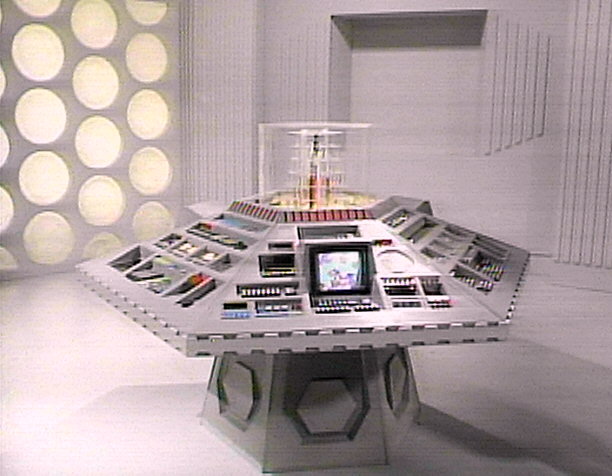
The Fifth Doctor's Console
Stepping inside the TARDIS is a remarkable experience, for the senses are overwhelmed in much the same way as entering a hall of mirrors distorts and changes our normal perceptions. For though it seems so small on the outside, inside, the craft is nearly infinite in size, a mass of rooms and passageways that stretch on for miles. In truth, we have stepped across a dimensional bridge. We are now in a different, but relative, dimension that exists outside of time.
The TARDIS is dimensionally transcendental, meaning that its interior exists in another dimension, as was said. The outer plasmic shell of the TARDIS is simply a door of crossing over from the safe confines of the alternate dimension, in real space and time. TARDIS machines are not composed of matter in its usual sense. Its outer plasmic shell is constructed by a type of complex mathematical Formulae called Block Transfer Computation. BTC's can be used to warp reality itself, creating an actual physical structure in Space/Time. It is by these means that a TARDIS is constructed. Because a TARDIS isn't a normal physical object, it cannot be harmed by ordinary physical forces. Only the Real World interface contacts the normal universe, granting it what is termed Temporal Invulnerability.
TARDIS machines are constructed by the Block Transfer method due to the nature of the Time/Space vortex. Normal physical objects cannot survive entry into the Vortex. Only constructs of pure mathematics can survive the environment. A TARDIS doesn't actually travel through the normal physical universe when their spatial Co-ordinates are changed, the TARDIS instead withdraws its Real World Interface (Dematerializes.), moves through the Space/Time Vortex to a different location, and then extends the Real World Interface once again (Materializes). The outer hull of the TARDIS is dematerialized and pushed through space, like a ball on a tether, and then is rematerialized. The door is mobile and the interior remains stationary.
The TARDIS is powered and controlled by various console rooms. There are four known console rooms, the Main Console Room, the Secondary Control, the Tertiary Console Room, and the Observation Console Room.
The Main Control Room is the most familiar. Upon entering the TARDIS from the Real World Interface, you are confronted with brilliant illumination and familiar walls covered by sunken circular designs, has in its center the most important piece of equipment in the TARDIS, the six-sided control console. This is the heart of the machine and on its smooth functioning depend the lives and well being of the Doctor and his companions.

The Fourth Doctor's Console
Each of the six sides of the console governs specific functions. The most important, naturally, controls the drive system of the TARDIS. On this section is mounted the the master dematerialization switch which, when operated, engages the TARDIS' power source, the Eye of Harmony, and "dissolves" or transports the Real World Interface from one point to another in space and time. A crucial part of this switch is the circuit which ensures that it does not materialize in a disastrous situation such as in the heart of a burning sun or inside solid rock.
Another of the six sections contains the guidance controls, while alongside this a third panel gives navigational read-outs. A fourth is linked to the TARDIS computers via a telepathic circuit link. This link is complimentary between the TARDIS and the Doctor, indeed, if anything were to ever happen to the Doctor, the shock would be so stressing on the TARDIS, that it too would die. In regenerational crises the TARDIS has been known to aid the Doctor by carrying him to safety or even aiding his regeneration. In all truth the TARDIS is sentient to the point where for all intents and purposes, it is alive. A further bank of switches and dials controls all the various recording and scanning equipment so necessary on the Doctor's missions. The last of the six sections supervises the protection of the machine, it is here that the HADS control as well as shield controls are located.
On the far side of the Main Console Room, are the large, thick interior doors that close when the TARDIS is in flight to seal off the TARDIS interior from the outer plasmic shell. The doors are very secure and cannot be forced open once closed. If they are opened in flight by mistake or malfunction, a dimensional instability forms between the TARDIS interior and the Real World Interface that can "shrink" the TARDIS exterior such that upon exiting, the occupants will have become shrunken. This occurred once to the Doctor, but the problem was easily rectified.
Also there is a scanner placed in the wall that when opened allow the outer surroundings of the TARDIS to be scanned to make sure it is safe to exit the craft. Next to this scanner is the TARDIS inner door which leads to the inner rooms and halls of the TARDIS.

TARDIS Interior from the Real World Interface.
The Secondary Console Room is antiquated and is used only in cases of extreme emergency. It contains wood-panelled walls and an antique control system. The Secondary console room is based on a wood paneled design that evokes less of a feeling of technology than do the other control rooms. Around the pedastool-like console, there is a brass circular bar that runs around the console area like a rail, perhaps for support in cases of attack. It is quite out of date and has only been used twice by the Doctor.
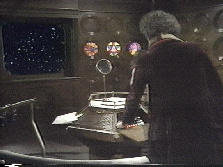
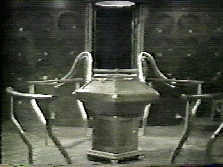
The Secondary Console Room as it was during the era of the Fourth Doctor
The Tertiary Console room is a stone/marble based design that has only been referred to in Virgin's New Adventure novels. It is the most tranquil of the three control rooms, being somewhat damp and cold. As this console room has never been seen, any speculation as to it's actual appearance and controls would be much appreciated.
There is also the Observation Console Room, or "battle bridge" that was used in the Doctor Who movie. This room is located close to the Eye of Harmony and thus has more maneuvering power for the TARDIS. The TARDIS has the ability to shift its Real World Interface entrance anywhere in the TARDIS. The large doors in this room can become the TARDIS main door should it be programmed. The room is vast and littered with bookshelves, a record player, furniture, clocks, and other articles that make this room more comfortable to operate from. The ceiling of this room is a large scanner that when activated can project the outer surroundings or the universe from their current location. The console in this room is large and also rather antiquated. It has a large pillar housing the time rotor that powers the TARDIS. It may be used in times of battle or as an emergency control room if one or more of the others are damaged. The console features a television readout monitor that displays system status as well as the destination and departure coordinates. It has a hand brake that can be used for emergency stopping of the TARDIS while in flight. A large slide lever controls the ceiling scanner and activates it.


The Observation Console. The Seventh Doctor at the console.
The TARDIS Interior:
The TARDIS interior is infinite in size. The TARDIS halls and rooms are limited in size however. That is, the Doctor can make as many rooms as he wants to without ever running out of room. The white halls with the familiar roundels, corridors that stretch onward. Many companions have gotten lost in these long and twisting corridors.
The interior of a TARDIS is versatile. Its operator can move or change rooms to suit his/her needs. Not only can rooms be moved around, but they can also be deleted or have their appearances radically altered, by simply changing the mathematical formulae that compose them. Certain rooms can be jettisoned, should it be required. Many times the Doctor has used the explosive thrust of ejecting part of the TARDIS to escape situations where the TARDIS doesn't have enough power to escape a situation on its own.
Within the TARDIS there are bedrooms, bathrooms, and a food court. There is also a pool room that is quite popular with the companions. Art galleries, a workshop, a hospital, laboratories, and many gardens can be found within this infinite structure. As well as many rooms used for storage. The storage rooms can be used when the Doctor materializes around an object and it can be taken with them. The TARDIS engine room is also within, but has never been seen.
The Cloister Room:
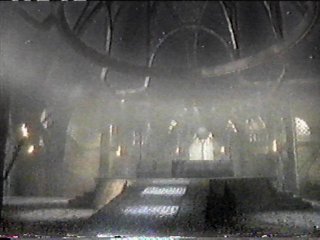
The Cloister Room
The Cloister Room is the most important room in the TARDIS, it is the "keystone". The room is vast and on the far end are tow twin balconies overlooking the Eye of Harmony and in a direct line with two of the four Reflector Staffs stationed around the Eye, which generate a small force field to protect the Eye from harm.
In the center of the Cloister Room is the Eye of Harmony. The Eye of Harmony is a miniature black hole that is dimensional linked to the black hole beneath the Panopticon on Gallifry. If the link is severed, then the TARDIS is powerless and begins to die. The Eye had been programmed by Rassilon to only be opened by a human as a security measure. In order to open the Eye, a reflector staff must be pulled from its mooring and the eyes of a human must be then placed in the light extruding from the hole to be scanned. Once they have been scanned, the Eye will open. The Eye if left opened too long can suck a planet through it and instigate a disastrous chain of events. The Doctor has never been able to open the Eye by himself. Should anyone fall into the Eye, the powerful forces of the Eye will disintegrate their bodies and they will be destroyed.
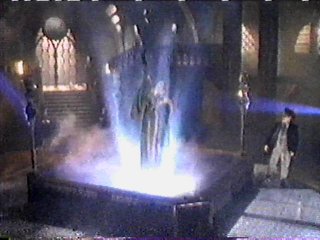
The Master being sucked into the Eye of Harmony
The room is also used to transfer the life of one Time Lord to another, with it transferring his remaining lives and memories. This can be done only when the Eye is open and the reflector staffs are in position. When the transfer begins, power from the Eye is sent out through the Reflector Staffs and the transfer begins. Should the Eye close or the drive system of the TARDIS activate, the transfer will cease and the process, wholly unfinished, will reverse itself, returning all lives and memories to the original Time Lord.
The Space Time Vortex:

The TARDIS in the Space-Time Vortex
When a TARDIS time travels, it passes through a space-time Vortex. The Time Vortex is an area beyond time and space which was created by the Time Lords. It seems that the Vortex was created as a sort of inter dimensional highway that has cutoffs which exited at every point in the known Universe. The Time Lords had their TARDISes but didn't have a place they could use they could use a conduit for time travel, so the space-time Vortex was created. Some entities, such as the Kronovores, the Guardians of Time, and the Mandragora Helix actually have taken up residence in the Vortex, making it a hazardous place at times.
|
?????????????????????????????????????? |
?????????????????????????????????????? |
